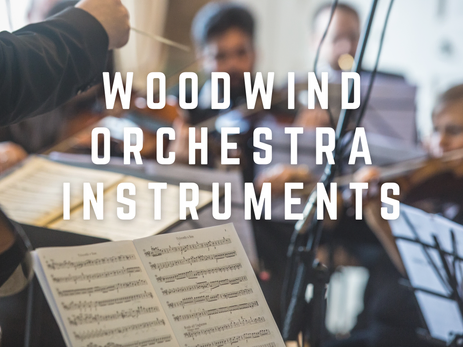Uncategorized
Woodwind Orchestra
Understanding Woodwind Section
Did you know that an oboe player can hold a note for more than twenty seconds?
Do you know what is the range of the bass clarinet?
If you answered “no” to the previous questions, you better keep reading this artic
le!
INTRODUCTION
In this chapter of our Orchestra Instruments Series, we will explain the range of each of the woodwind orchestra as well as their registral characteristics and peculiarities.
Here we list five families that make up the woodwind section:
- Flute family
- Oboe family
- Clarinet family
- Bassoon family
- Saxophone family
Apart from the classification by families, we can classify these instruments according to the type of reed they use:
- Nonreed instruments: all flutes
- Sigle reed: all clarinets and saxophones
- Double reeds: oboe, English horn, bassoon, contrabassoon
Now let’s see the particularities of each family!
FLUTE FAMILY
This family is made up of the piccolo, the flute, the alto flute and the bass flute.
There are three fundamental aspects that we must remember when writing for flute:
- Flute music is written in treble clef
- The regular flute is a non-transposing instrument
- It requires a lot of air
The range of the flute goes from C4 to C7, as illustrated below:
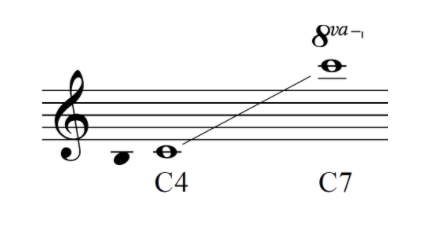
The flute has a weak sound in its lowest register, a sweet sound in the middle register, and a clear sound in the third octave. We recommend not using the highest register as it sounds a bit shrill.

The trills shown below are impossible to play on the flute.

Piccolo
There are three fundamental aspects that we must consider when writing for piccolo:
- Piccolo music is written in treble clef
- It sounds one octave higher than written
- The Piccolo has the same fingerings as the flute
The written range of the piccolo extends from D4 to C7

Alto Flute
The alto flute is a transposing instrument that sounds a perfect fourth lower than written.
Like the other members of the family, it is written in the treble clef and its written range extends from C4 to C7.
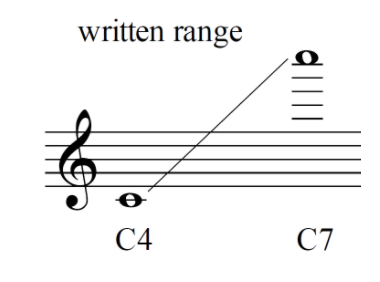
Its registral characteristics are the following:

Bass Flute
The bass flute is a transposing instrument that sounds one octave lower than written. It is important to notice that, despite being a low-pitched instrument, it must be written in treble clef. As in the regular flute, the written range of the bass flute extends from C4 to C7.
OBOE FAMILY
There are three fundamental aspects that we must consider when writing for the oboe:
- It is a non-transposing instrument
- Is able to hold notes for a long time (for about 20 seconds!)
- Tends to honk in the lowest fifth of its range
As we mentioned in the introduction, professional oboe players can hold a note for more than 20 seconds. This is because, unlike flutes, the oboe uses a little amount of air.
The range of the oboe extends from Bb3 to G6:
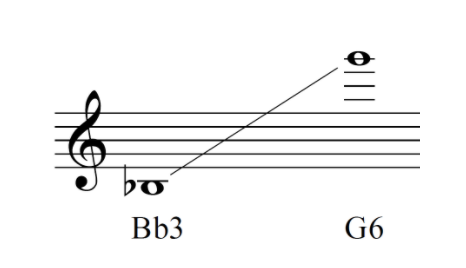
As we mentioned earlier, the oboe tends to honk in the lower register. Therefore, is better to use this register in loud-dynamic passages such as forte or fortissimo. The middle register sounds warm and prominent. The register from B5 to E6 sounds thin. From F6 upwards sounds pinched and ineffective.

Trills and tremolos are possible almost anywhere in the oboe. However, keep in mind that large-interval tremolos above the staff are difficult.
The trills shown below are impossible to play on the oboe.
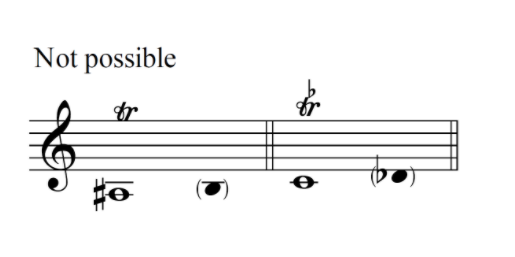
English Horn
It is an instrument that sounds a perfect fifth lower than written. It is written in the treble clef and its written range, very similar to that of the oboe, extends from B3 to G6
Among the composers who used this instrument in their orchestral works, we can mention Jean Sibelius, Hector Berlioz, Richard Wagner and Maurice Ravel.
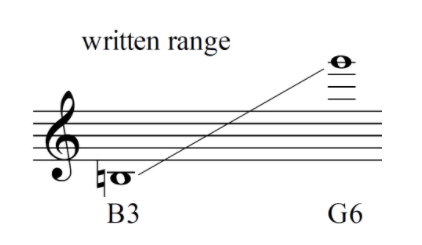
CLARINET FAMILY
The clarinet family has seven different members. In this article, we will focus on the three most used in orchestral literature.
There are some important aspects to consider when writing for clarinet:
- All clarinets are written in treble clef
- All clarinets have the same fingering system
- All clarinets are transposing instruments
- The regular clarinet (Bb) sounds a major second lower than written
The C clarinet became practically obsolete in the orchestras of Europe and the United States in the early twentieth century. The written range of the clarinet extends from E3 to A6.
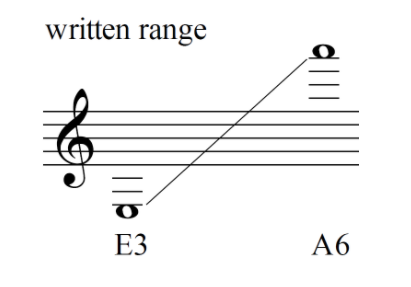
The lower register is called the chalumeau register. The chalumeau was a single-reed instrument used in the late baroque and classical eras and it is considered the predecessor of the modern-day clarinet. The notes G4, G#4, A4 and Bb4 sound pale and are called “throat tones”.
The register from B4 to C5 is called the clarino register. Its name is due to the fact that in the Middle Ages and Renaissance through the 18th century, clarino was the name for a trumpet.
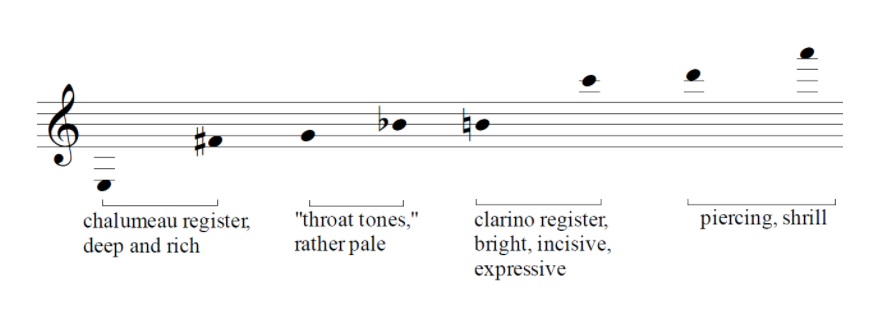
Although the clarinet is an effective instrument for playing trills and tremolos, we must consider that large-interval tremolos above the stuff are difficult to execute.
Eb Clarinet
The famous Eb clarinet sounds a minor third higher than what you see written on the score.
It has the same fingerings and written range as the Bb clarinet. Therefore, the sounding range extends from G4 to C7.
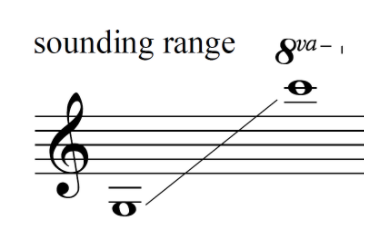
Bass Clarinet
The main features of the bass clarinet are the following:
- Is written in treble clef
- Sounds a major ninth lower than written
- Has the same fingerings as the Bb clarinet
Unlike the other members of the family, the lowest pitch on the bass clarinet is an Eb.
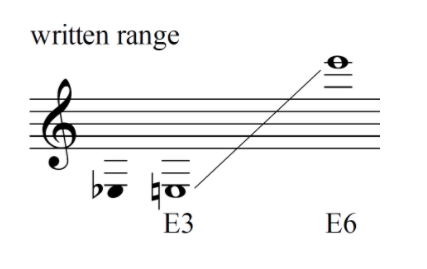
BASSOON FAMILY
The main features of the bassoon are the following:
- Is the bass voice of the wind section
- Is notated in the bass clef, but uses the tenor clef when the ledger lines begin to accumulate
- It is a non-transposing instrument
- It is a versatile and agile instrument
The range of the bassoon extends from Bb1 to Eb5.
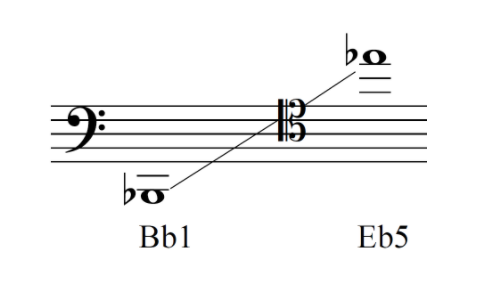
The great orchestrators have known to take advantage of each of the bassoon registers and their particular timbres.

Stravinsky´s most famous work, The Rite of Spring, begins with a bassoon in its higher register because the composer was looking for a thin sound.
In regards to trills and tremolos, while the former is effective in bassoon writing, tremolos are not idiomatic. Therefore, they should never exceed a perfect 4th.
Contrabassoon
There are four main aspects that we must consider when writing for contrabassoon:
- Is the lowest of the woodwinds
- Sounds an octave lower than written
- Uses the same techniques as the bassoon
- Avoid fast staccato passages
The contrabassoon is a very low-pitched instrument. Its written range is the same as that of the bassoon. Consequently, its sounding range extends from Bb0 to Bb3.
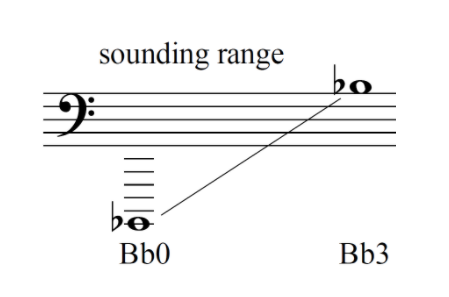
SAXOPHONE FAMILY
The saxophone was invented by Adolphe Sax in 1840, approximately. The most widely used saxophones today are the soprano (Bb), alto (Eb), tenor (Bb), and baritone (Eb). However, there are other members in the family such as the sopranino and the bass saxophone. Although the saxophone has not been fully accepted in the symphony orchestra, several composers have included passages for this instrument in their orchestral works.
Among the most famous solos in the orchestral repertoire, we can mention the following:
- The Old Castle (Pictures at an exhibition) – Modest Músorgski (orchestrated by Maurice Ravel)
- Bolero – Maurice Ravel
- An American in Paris – George Gershwin
There are some important aspects that we have to consider when writing for saxophone:
- All saxophones are written in treble clef
- All saxophones have the same fingering system
- All saxophones are transposing instruments
The written range of all saxophones extends from Bb3 to F6.
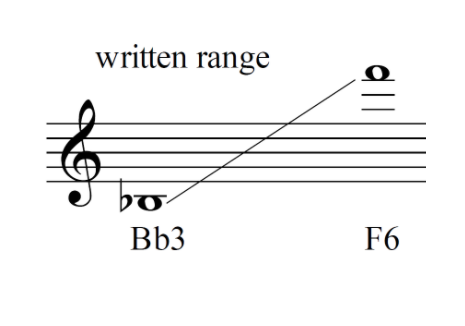
Soprano Saxophone
The soprano saxophone sounds a major second lower than written. If the saxophonist plays a melody written in C major, it will sound in Bb major, ass illustrated below.

Alto Saxophone
This type of saxophone sounds a major sixth lower than written. If the saxophonist plays a melody written in C major, it will sound in Eb major.

Tenor Saxophone
The Tenor Saxophone sounds a major ninth lower than written. If the saxophonist plays a melody written in C major, it will sound in Bb major (but a major ninth lower than written).

Baritone Saxophone
This instrument is written in treble clef despite being a low-pitched instrument.
With regard to transposition, it sounds a compound major sixth lower than written, as illustrated below.

You have learned all the main characteristics of wind instruments. Now you just need to put into practice what you have learned. In the following article, we will explain how to orchestrate a piece using the woodwind section. Stay tuned!
You can also see all these concepts in our Music Video Tutorials links below:
https://www.youtube.com/watch?v=gKAEF77w8Qwhttps://www.youtube.com/watch?v=qgXo3uOnFJI&t=16s
ORCHESTRATING SCHUMANN’s SOLDATENMARSCH
Now, within this section, we will orchestrate Schumann‘s Soldatenmarsch Op. 68, No. 2 for woodwinds as an example for you to understand what is seen in this article.
First of all, we will analyze the piece and then we will see how to orchestrate it.
ANALYSIS
Soldatenmarsch is the second piece of the Album for the Young, which was composed in 1848 and consists of 43 short pieces for piano.
Let’s start by doing an analysis of the first 8 bars.

Key
The key of this section is G major. The piece begins in a very conventional way, with a tonic chord in root position.
Texture
The first section of the piece presents a four-part texture in which all voices are moving with the same rhythm, which is known as homorhythmic texture.
Form
The first section of the piece is made up of 8 measures which are divided into 4 + 4. the first 4 bars make up a phrase that rests in a perfect authentic cadence while the second group of 4 measures rest on a half-cadence.
Harmony
The harmonic progressions used in this piece are very conventional and conform to the style of the common-practice period.
ORCHESTRATION
One of the most basic aspects that we must consider when orchestrating is to determine if the compass of the part that we want to orchestrate coincides with the register of the instrument that we want to use. Next, we will give a more detailed explanation.
The ambitus of the top part extends from G4 up to G5, which indicates that we can use a flute, an oboe, or a clarinet for that passage.
The alto part extends from F#4 to E5. The choice of the instrument is subordinate to the timbre we choose for the soprano.
The tenor part only participates in bars 4 and 8. We must choose an instrument that blends with the soprano and alto parts.
In order to obtain homogenous chords and balance in the orchestration, the timbre of the bass part will be similar to that of the other woodwinds.
Here is a way to orchestrate the first 8 bars of this piece:
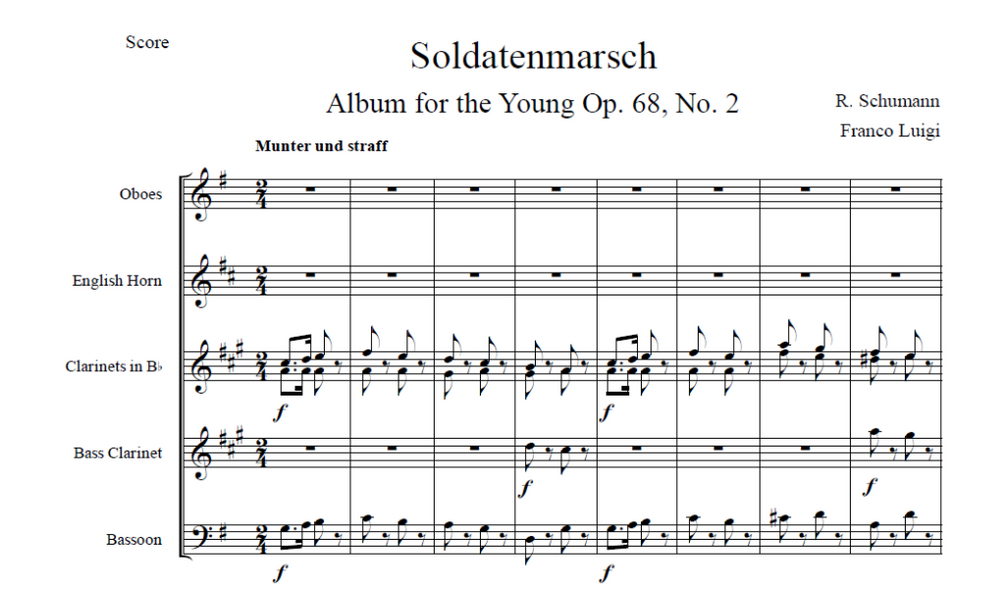
In the piano sheet music, measures 9 to 16 are an exact repetition of the first 8 measures. In order to make an interesting orchestration, we will change the tone colour in the repetition. We illustrate the result below:
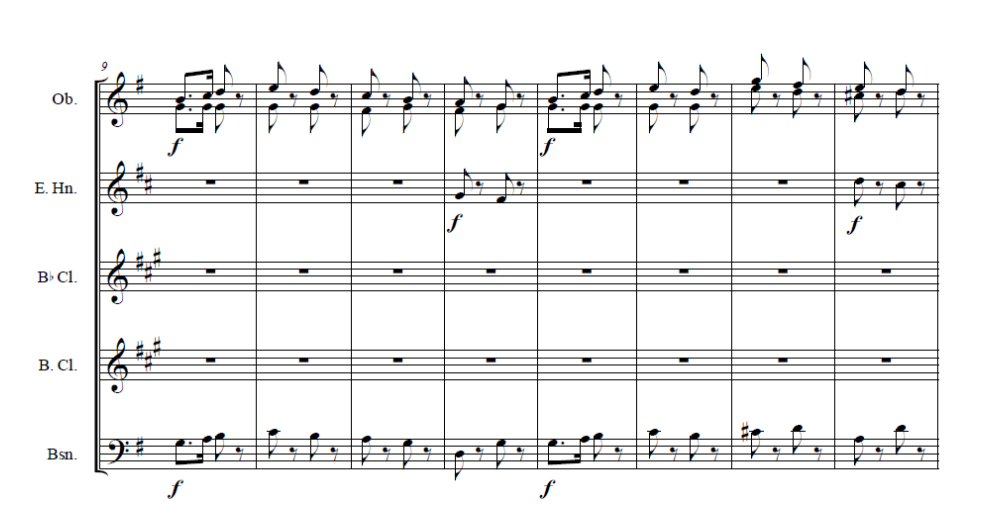
We have already analyzed and orchestrated the first section of the piece.
Now let’s look at the next section!

The most striking thing about this section is that a new texture appears: There is an alternation between two measures of monophonic texture and two measures of homorhythmic texture.
We have orchestrated the monophonic texture with a clarinet and a bass clarinet. Instead, we have used two oboes, an English horn, and a bassoon for the homorhythmic texture. In this way, using different timbres, we are emphasizing the changes of texture.
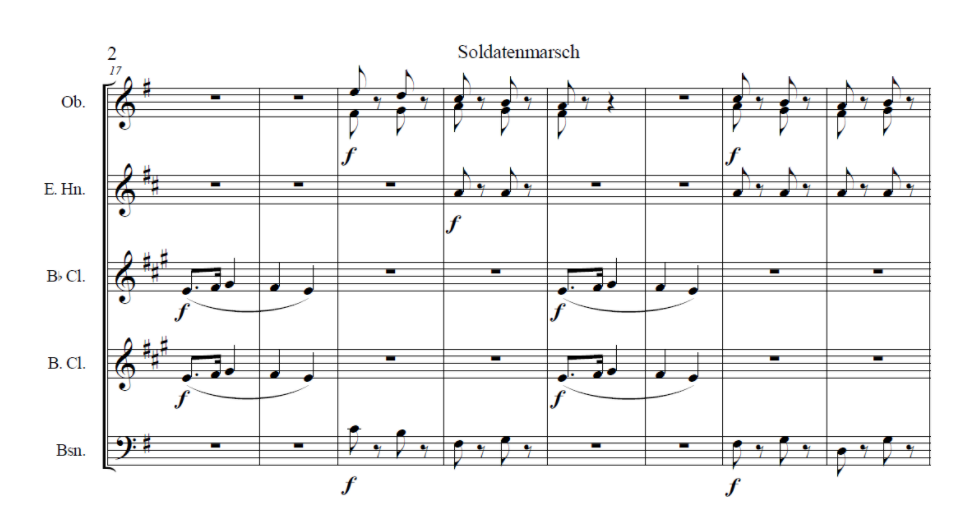
We have already orchestrated 75% of the piece. Now we only have to orchestrate the last 8 measures which will be very simple since it is the same material presented at the beginning of the piece.
Below, we show the orchestration of the last 8 bars plus the final cadence.
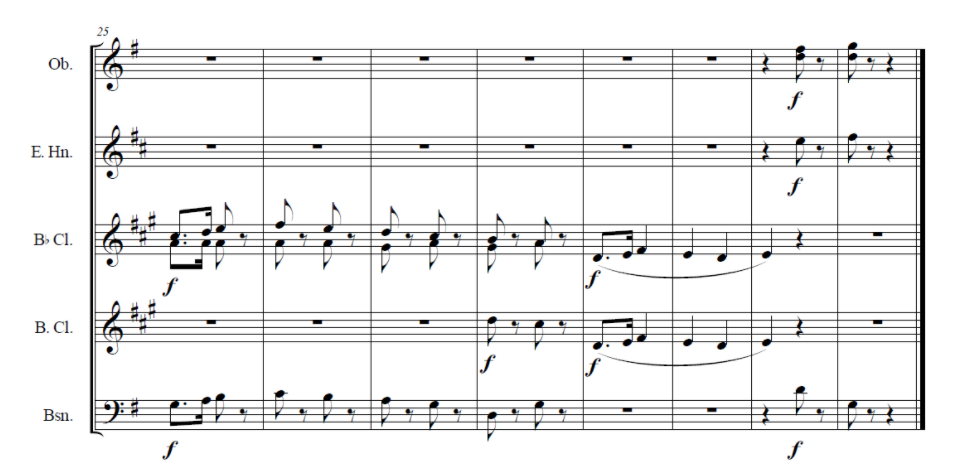
SCORING FOR WOODWINDS
In this section, we will talk about issues related to writing in the woodwinds as well as different possibilities of orchestrating chords with woodwinds. Furthermore, we will dedicate a section of the article to explain how to orchestrate a piece from Tchaikovsky‘s youth album.
To begin, let’s see what is the order of appearance of the woodwind instruments in an orchestral score.
The eighteen-century orchestra used to employ winds by two, that is, 2 flutes, 2 oboes, 2 clarinets and 2 bassoons.
The following example shows the order of appearance of the instruments in the score:
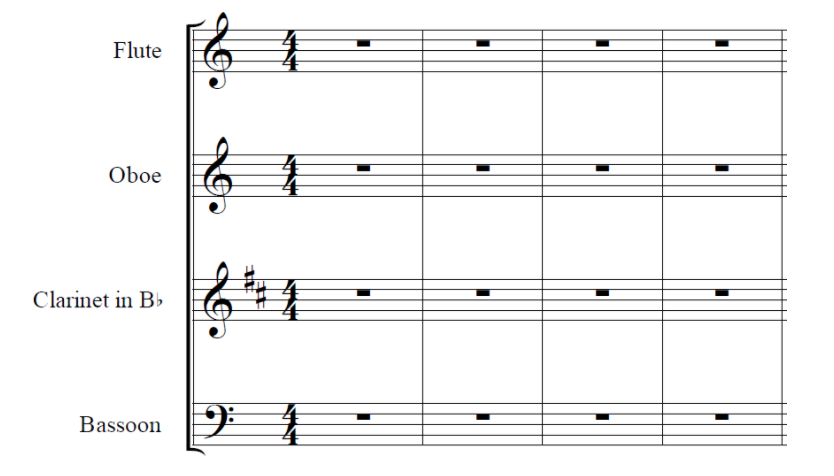
Composers after Beethoven expanded the woodwind section through the use of auxiliary instruments. Next, we illustrate the order of appearance of the regular instruments plus the most commonly used auxiliary instruments.
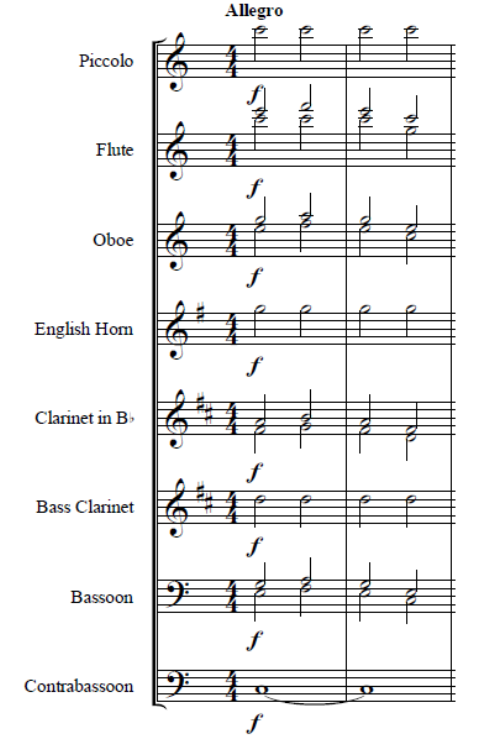
If we look closely at the last example, we will see that the first and second parts of identical instruments are written on the same staff, the first part with stems going upwards while the second part with stems going downwards.
On the other hand, it is important to notice that the Bb clarinets, Bass clarinet and English horn have different key signatures than the rest of the instruments since they are transposing instruments.
Now that we know how to write a score for the woodwind section, let’s look at different possibilities for orchestrating chords.
1. CHORDS FOR WINDS IN PAIRS
Chords for winds in pairs may be voiced in four ways:
SUPERIMPOSING
Is the most used voicing. When using this voicing, make sure the melody is in a good register for the assigned instrument.
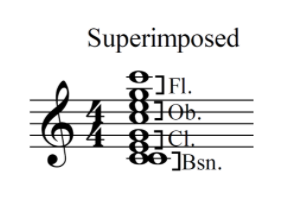
INTERLOCKING
This voicing mixes the wind colours. Avoid imbalance between different instruments.
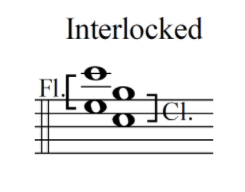
ENCLOSING
The problems that could arise with this technique are the same as those that arise with interlocking. Namely, the imbalance between different instruments.
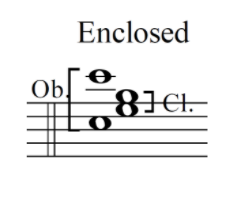
OVERLAPPING
This technique obscures the timbral characteristics of both sets of instruments and often results in strengthening a pitch that does not need that kind of emphasis.
However, this technique is commonly employed in orchestral tutti passages.
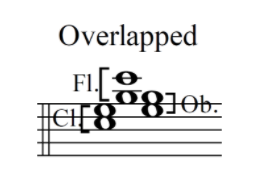
2. CHORDS IN WHICH EACH NOTE HAS A DIFFERENT TIMBRE
These types of chords are often difficult to balance. For this reason, we advise against its use. However, they work well when each instrument is placed in its most advantageous register. The example below illustrates one chord with inefficient voicing and two chords with effective voicing.
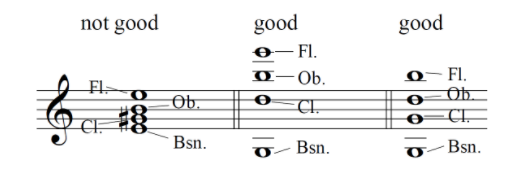
The first chord has an inefficient voicing because the bassoon is playing in a relatively high register while the clarinet and oboe are playing in a comfortable register. Furthermore, the flute could be overshadowed by the oboe.
The remaining two chords are effective because each instrument plays in an advantageous register.
Finally, let’s put what we have learned into practice and see how to orchestrate the first eight bars of Tchaikovsky’s “Morning prayer” Op. 39, No. 1.

Measures 1 – 4
We will assign the two parts of the right hand to the oboes since the extension of this instrument coincides with the compass of the piano parts. Following a similar logic, we will assign the two parts of the left hand to the bassoons. As a result, we obtain a four-voice chord progression executed by two timbres with a nasal quality.
Measures 5 – 8
In these bars, we are going to look for a timbral contrast. Therefore, we will assign the right-hand parts to the clarinets and the left hand’s parts to the bassoons.
Below we show the score of the piece orchestrated with woodwinds:
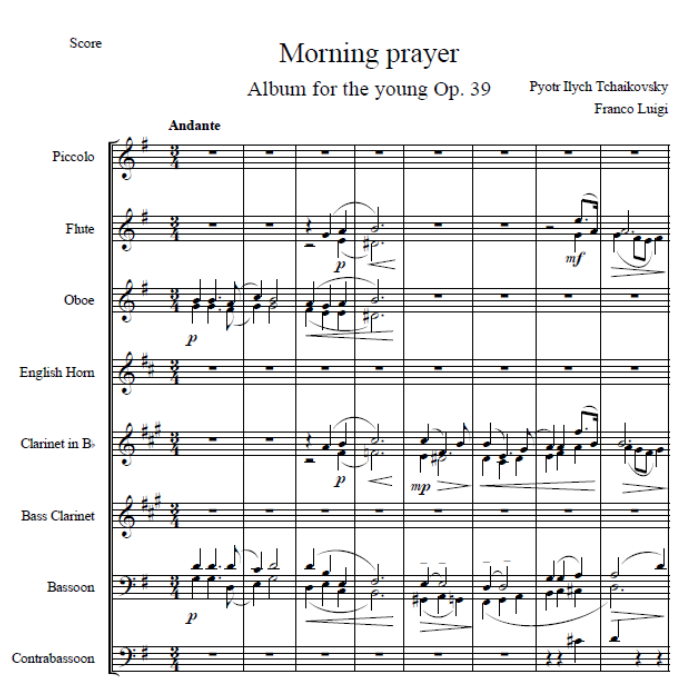
With this article, we conclude this chapter on Woodwind Instruments.
We hope it has been useful for you.

